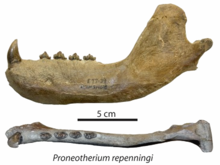
The walrus is a large pinniped marine mammal with discontinuous distribution about the North Pole in the Arctic Ocean and subarctic seas of the Northern Hemisphere. It is the only extant species in the family Odobenidae and genus Odobenus. This species is subdivided into two subspecies: the Atlantic walrus, which lives in the Atlantic Ocean, and the Pacific walrus, which lives in the Pacific Ocean.

Deinotherium is a genus of large extinct elephant-like proboscideans that appeared in the Middle Miocene and survived until the Early Pleistocene. Although superficially resembling modern elephants, they had notably more flexible necks, limbs adapted to a more cursorial lifestyle as well as tusks emerging from the lower jaw that curved downwards and back, lacking the upper tusks present in other proboscideans. Deinotherium was a widespread genus, ranging from East Africa to southern Europe and to the east in the Indian subcontinent. They were primarily browsing animals with a diet mainly consisting of leaves, and they most likely went extinct as forested areas were gradually replaced by open grassland during the latter half of the Neogene, surviving longest in Africa, where they persisted into the Early Pleistocene.

Caniformia is a suborder within the order Carnivora consisting of "dog-like" carnivorans. They include dogs, bears, raccoons, and mustelids. The Pinnipedia are also assigned to this group. The center of diversification for the Caniformia is North America and northern Eurasia. Caniformia stands in contrast to the other suborder of Carnivora, the Feliformia, the center of diversification of which was in Africa and southern Asia.
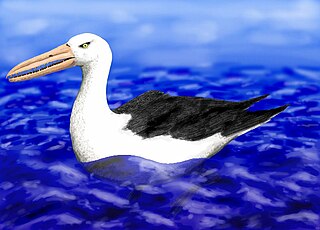
Osteodontornis is an extinct seabird genus. It contains a single named species, Osteodontornis orri, which was described quite exactly one century after the first species of the Pelagornithidae was. O. orri was named after the naturalist Ellison Orr (1857-1951).

Enaliarctos is an extinct genus of pinnipedimorph, and may represent the ancestor to all pinnipeds. Prior to the discovery of Puijila, the five species in the genus Enaliarctos represented the oldest known pinnipedimorph fossils, having been recovered from late Oligocene and early Miocene strata of California and Oregon.

Desmatophoca is an extinct genus of early pinniped that lived during the Miocene, and is named from the Greek "phoca", meaning seal. A taxon of the family Desmatophocidae, it shares some morphological similarities with modern true seals. Two species are recognized: Desmatophoca oregonensis and Desmatophoca brachycephala. Little information exists regarding Desmatophoca, due to the small number of fossil samples obtained and identified.

Imagotaria is an extinct monotypic genus of walrus with the sole species Imagotaria downsi. Fossils of Imagotaria are known from the early late Miocene of California.

Ontocetus is an extinct genus of walrus, an aquatic carnivoran of the family Odobenidae, endemic to coastal regions of the southern North Sea and the southeastern coastal regions of the U.S. during the Miocene-Pleistocene. It lived from 13.6 mya—300,000 years ago, existing for approximately 13.3 million years.
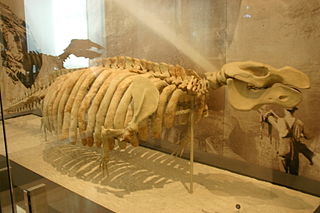
Metaxytherium is an extinct genus of dugong that lived from the Oligocene until the end of the Pliocene. Fossil remains have been found in Africa, Europe, North America and South America. Generally marine seagrass specialists, they inhabited the warm and shallow waters of the Paratethys, Mediterranean, Caribbean Sea and Pacific coastline. American species of Metaxytherium are considered to be ancestral to the North Pacific family Hydrodamalinae, which includes the giant Steller's Sea Cow.

Euthecodon is an extinct genus of long-snouted crocodile. It was common throughout much of Africa during the Neogene, with fossils being especially common in Kenya, Ethiopia, and Libya. Although superficially resembling that of gharials, the long snout was a trait developed independently from that of other crocodilians and suggests a diet of primarily fish. Euthecodon coexisted with a wide range of other crocodiles in the areas it inhabited before eventually going extinct during the Pleistocene.

Paleontology in Oregon refers to paleontological research occurring within or conducted by people from the U.S. state of Oregon. Oregon's geologic record extends back approximately 400 million years ago to the Devonian period, before which time the state's landmass was likely submerged under water. Sediment records show that Oregon remained mostly submerged until the Paleocene period. The state's earliest fossil record includes plants, corals, and conodonts. Oregon was covered by seaways and volcanic islands during the Mesozoic era. Fossils from this period include marine plants, invertebrates, ichthyosaurs, pterosaurs, and traces such as invertebrate burrows. During the Cenozoic, Oregon's climate gradually cooled and eventually yielded the environments now found in the state. The era's fossils include marine and terrestrial plants, invertebrates, fish, amphibians, turtles, birds, mammals, and traces such as eggs and animal tracks.
The Astoria Formation is a geologic formation in Washington state & Oregon. It preserves fossils dating back to the early to middle Miocene.

Enhydriodon is an extinct genus of mustelids known from Africa, Pakistan, and India that lived from the late Miocene to the early Pleistocene. It contains 9 confirmed species, 2 debated species, and at least a few other undescribed species from Africa. The genus belongs to the tribe Enhydriodontini in the otter subfamily Lutrinae. Enhydriodon means “otter tooth” in Ancient Greek and is a reference to its dentition rather than to the Enhydra genus, which includes the modern sea otter and its two prehistoric relatives.
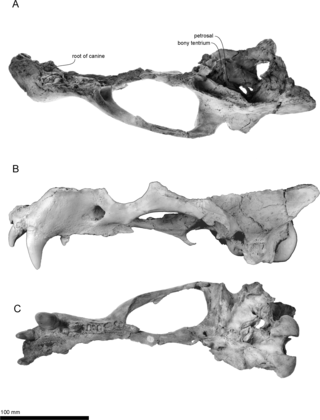
Archaeodobenus is an extinct genus of pinniped that lived during the Late Miocene of what is now Japan. It belonged to the Odobenidae family, which is today only represented by the walrus, but was much more diverse in the past, containing at least 16 genera.
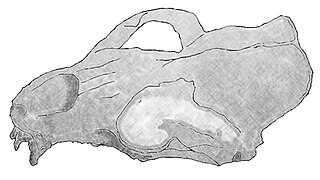
Prototaria is an extinct genus of pinniped that lived approximately 15.97 to 13.65 mya during the Middle Miocene in what is now Japan. It belonged to the family Odobenidae, the only extant species of which is the walrus. Members of the genus Prototaria are believed to be the most basal imagotariine pinnipeds.

Nanodobenus is an extinct genus of pinniped that lived approximately 15.97 to 7.246 mya during the Miocene in what is now Baja California Sur, Mexico. It belonged to the family Odobenidae, the only extant species of which is the walrus.
Kamtschatarctos is an extinct genus of pinniped that lived approximately 15.97 to 11.608 mya during the Early Miocene in the Kavran-Ukhtolok Bay of Russia's Kamchatka Peninsula. It belonged to the family Odobenidae, the only extant species of which is the walrus.
Osodobenus is an extinct genus of walrus from the Miocene to Pliocene of California. Osodobenus may have been the first tusked walrus and shows several adaptations that suggest it was a suction feeder, possibly even a benthic feeder like modern species. Three skulls are known showing pronounced sexual dimorphism, with the female lacking the same tusks as the male. Only a single species, Osodobenus eodon, is currently recognized.
Sacacosuchus is an extinct monospecific genus of marine gavialid that lived along the coast of the south-east Pacific from approximately 19 to 6.3 million years ago. Its fossils have been found in the Chilcatay and Pisco Formations of Peru, where it coexisted with the much larger Piscogavialis. Based on its skull, Sacacosuchus was most likely a generalist feeder with an estimated total body length of 4.32 m (14.2 ft). Its extinction is thought to have been caused by a combination of factors including falling sea levels and global cooling.

Kinyang is an extinct genus of osteolaemine crocodile from the Early to Middle Miocene of Kenya. Two species are currently known, K. mabokoensis from the Lake Victoria basin and K. tchernovi from the Lake Victoria and Lake Turkana basin. Kinyang had an exceptionally broad and robust skull, much wider than that of any living crocodile species. This might have allowed it to attack and kill prey its own size or even bigger. Kinyang is notably larger than its contemporary relative Brochuchus. While the precise reasons for the extinction of Kinyang are not known, it coincides with a larger faunal turnover that saw osteolaemines replaced by the still dominant crocodylines. One reason for this shift may have been the drying climate of Africa at the time, which caused rainforests to be replaced by more open environments and disrupted the nesting behavior of osteolaemines due to their dependence on foliage.
